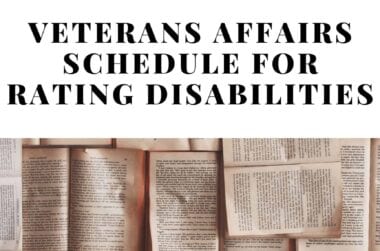Looking for Expert-Level VA Claim Answers?📱Call Us Now! 737-295-2226
If you’re a veteran trying to understand how your conditions are rated for disability compensation, you’ve probably come across something called the VASRD—short for Veteran Affairs Schedule for Rating Disabilities.
It’s the rulebook the VA (and now the military) uses to determine how much your service-connected conditions affect your life, and what kind of benefits you may be eligible for.
In this post, we’ll break down exactly what the VASRD is, how VASRD codes work, and what you can do if your condition doesn’t have a code or was rated incorrectly.
Table of Contents
Summary of Key Points
- The VASRD (Veteran Affairs Schedule for Rating Disabilities) is the legal framework used to assign disability ratings based on how much a condition affects a veteran’s ability to work and function.
- Each condition is assigned a VASRD code, also known as a diagnostic code (DC) — these are four-digit numbers used to guide rating decisions.
- If a condition isn’t listed in the VASRD, it can be rated analogously under the closest comparable code based on similar functions, anatomical location, and symptoms.
- Veterans can appeal VASRD code decisions or ratings if there’s strong evidence that another code or a higher rating is more appropriate.

What is the VASRD?
The VASRD is a federal regulation that outlines how the VA assigns disability ratings to service-connected conditions. It’s designed to reflect how much a medical issue limits your ability to work and perform daily activities—and ultimately determines the level of monthly compensation you receive.
While technically a regulation, the VASRD has the force of law. That means when the VA assigns your rating, they’re bound by its criteria.
As part of that process, every condition gets assigned a VASRD code, also known as a diagnostic code (DC). These four-digit codes are how the VA identifies and rates specific medical conditions. Whether you see the term VASRD code or diagnostic code, they refer to the exact same thing—and they’re critical to understanding your disability rating.
For the full VASRD regulation, see HERE.
Why Does the VASRD Matter?
Each rating in the VASRD ties directly to how severely your condition impacts your life.
For example:
- Can you maintain employment?
- Are daily tasks like walking, lifting, or sleeping affected?
- Do you need ongoing treatment or adaptive equipment?
Pro Tip: VA ratings range from 0% to 100% in 10% increments. A higher combined VA rating = higher monthly compensation! See our VA Disability Calculator HERE.
What are VASRD Codes?
Each condition listed in the VASRD is assigned a four-digit code. This is called a VASRD code, or Diagnostic Code (DC). These codes help the VA track your condition and apply the correct rating criteria based on symptoms, treatments, and limitations.
Examples:
- Diagnostic Code 5237 = Lumbosacral strain (back injury)
- Diagnostic Code 9411 = PTSD (Post-traumatic stress disorder)
But what if your condition doesn’t have its own VASRD code?
That’s where analogous ratings come in.
Analogous Ratings: When Your Condition Isn’t Listed
The VASRD doesn’t cover every possible medical condition. If your exact condition isn’t listed, the VA may choose the closest comparable code based on similar functions, anatomical location, and symptoms. This is called rating by analogy—and it’s perfectly legal and common.
Example:
There’s no specific VASRD code for mild memory loss, but if it results from a condition like traumatic brain injury (TBI) or PTSD, the VA may rate it under the code for the underlying condition—such as TBI (Diagnostic Code 8045) or mental health conditions (e.g., PTSD, Code 9411)—depending on how the memory issues affect daily functioning and employability.
Learn more about analogous ratings HERE.
How VASRD Codes Are Assigned
When you submit a VA disability claim, a VA rating authority reviews your medical evidence and decides:
- Which VASRD codes apply to your conditions
- What rating percentage each condition deserves
For military disability through the DoD, the Physical Evaluation Board (PEB) assigns VASRD codes and ratings, often using the VA’s evaluation as a starting point.
You can find your assigned VASRD codes on:
- VA Rating Decisions
- PEB Findings
- eBenefits or VA.gov accounts
Can You Challenge a VASRD Code?
Yes—if you believe your condition was rated under the wrong code, or deserves a higher rating, you can file an appeal.
To improve your odds:
- Understand why a different code would be more appropriate
- Include medical evidence supporting the change
- Use VA language and cite VA rating criteria
To file or check an appeal, see HERE.
See also: How to Appeal a VA Claim Denial with this Decision Tree!
Do VASRD Codes Ever Change?
Yes. As medical knowledge advances, the VA updates the rating criteria and sometimes:
- Changes existing codes
- Creates new codes
- Retires old ones
The VA started a full overhaul of the VASRD in 2014, and the process is still ongoing! So, if your separation was years ago, you may have been rated under an older version.
Wrapping Up
The VASRD is complicated, and it’s not always fair. But knowing how it works puts you in a better position to fight for the rating (and compensation) you’ve earned.
If your condition isn’t listed…if your rating doesn’t match your symptoms…if you’re ready to increase your rating…VA Claims Insider has your SIX!
Our team understands how the VASRD works and how to increase your VA rating with strategy, education, and strong medical evidence.
(FAQs) Frequently Asked Questions
What is a VASRD code?
A four-digit code that identifies and explains how the VA should rate a specific medical condition.
Who created the VASRD?
The VASRD was created by a Congress-appointed committee made up of doctors, legal experts, and VA representatives. It’s reviewed periodically to keep up with medical advances. A major update began in 2014—and it’s still ongoing today.
Are VASRD codes and diagnostic codes the same thing?
Yes. The VA uses the terms VASRD code and diagnostic code (DC) interchangeably. Each code refers to a specific condition listed in the Veteran Affairs Schedule for Rating Disabilities (VASRD) and includes detailed criteria for assigning a disability percentage based on symptoms and severity.
What does an 8-digit code mean?
It’s an analogous code (e.g., 8099-8001). The first part (8099) shows it’s not listed in the VASRD; the second part (8001) shows what it’s being rated under.
Who decides which code applies?
VA rating authorities or the DoD’s PEB, depending on the branch reviewing your case.
Can I appeal my code or rating?
Yes—if you have supporting evidence. You can’t appeal to the law itself, but you can request a higher rating or a more appropriate code based on your medical documentation.
Want Expert-Level Support with Your VA Disability Claim? WE GOT YOUR SIX!
How does VA Claims Insider support veterans?
We make the confusing and frustrating VA claim process EASY through our 8-step proprietary system and one-on-one coaching; we’re the VA Claim EXPERTS you can trust, and YOU are never alone in this journey.
You’ll also receive VA disability expert Brian Reese’s SEM Method Blueprint—a proven formula that has educated over 25,000 veterans to win their VA disability claims faster:
Strategy + Education + Medical Evidence = VA Rating and Compensation You Deserve FASTER!
Start today and unlock an exceptional level of service you deserve for serving our country:
- You’ll hear from a VA Claim Expert over email within 15 minutes of signing up today.
- You’ll hear from your Veteran Coach team within 24 hours of all inquiries during normal business days/hours.
Click the red button below to start the process of winning your VA claim right now!
About VA Claims Insider
- VA Claims Insider is the #1 most trusted name in VA disability claims.
- Work directly with a VA claims coach who can educate you to VA claim victory.
- 25,000+ disabled veterans have served in our membership programs since 2016.
- 30% average rating increase for veterans who complete our #1-rated Elite program.
- 4.7/5.0 average rating out of 5,500+ total reviews; over 4,500 5-star reviews.

Eric Webb
Eric has written and worked in the field of Veterans Disability since 2020 and enjoys writing educational content for the veteran population. His prior work has been published in the Official Journal of the American College of Sports Medicine (ACSM). He holds a Degree in Health and Exercise Science.



